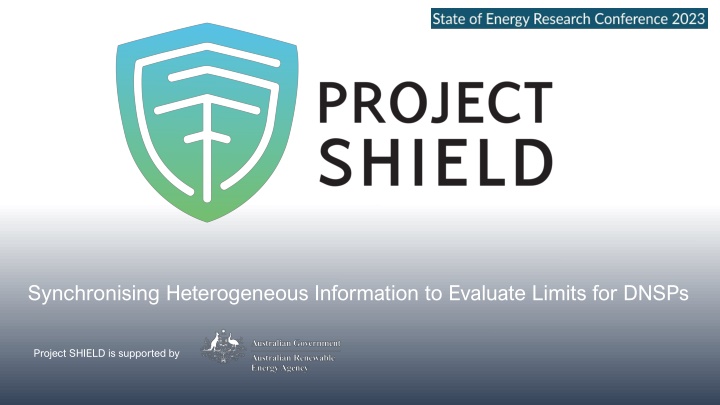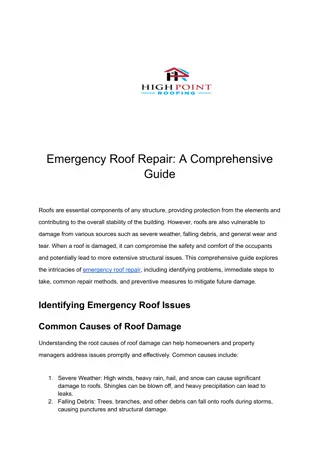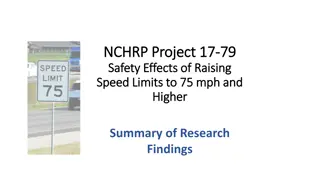Evaluating Limits for DNSPs Project SHIELD
Project SHIELD integrates data from diverse sources on the low-voltage network to assess available network capacity for grid operators in a high-density CER environment. The project aims to increase PV hosting capacity in the LV network through a data-driven approach, showcasing the feasibility of alternative methods to enhance network visibility, reduce investment needs, and lower network charges for consumers.
Download Presentation

Please find below an Image/Link to download the presentation.
The content on the website is provided AS IS for your information and personal use only. It may not be sold, licensed, or shared on other websites without obtaining consent from the author.If you encounter any issues during the download, it is possible that the publisher has removed the file from their server.
You are allowed to download the files provided on this website for personal or commercial use, subject to the condition that they are used lawfully. All files are the property of their respective owners.
The content on the website is provided AS IS for your information and personal use only. It may not be sold, licensed, or shared on other websites without obtaining consent from the author.
E N D
Presentation Transcript
Synchronising Heterogeneous Information to Evaluate Limits for DNSPs Project SHIELD is supported by
Project SHIELD overview Project SHIELD overview Project SHIELD : This Project seeks to integrate data from a range of heterogeneous sources on the low-voltage network in order to evaluate available network capacity for grid operators in a high-density CER environment. Budget: $5.7M, including $2.6M from ARENA Timeline: January 2021 to July 2023 Note: The views expressed herein are not necessarily the views of the Australian Government, and the Australian Government does not accept responsibility for any information or advice contained herein.
Background and project purpose Background and project purpose Rooftop solar, Battery storage and EVs play an important role in our net zero transition. Integration starts with understanding how CER affects power quality at a neighbourhood level. That requires data. Outside of Victoria, Smart meters are installed on approx 30% of connection points. At current rates, AEMO suspects it will be 2040 before full roll out. Our research seeks to find alternate methods to improve low voltage network visibility. Project SHIELD demonstrates the feasibility of a data-driven approach to increase PV hosting capacity in the LV network.
Data strategy and working assumption Data strategy and working assumption Lack of access to data results in LV network visibility being a challenge for most DNSPs Project Assumptions: There are various potential data sources installed in-front and behind the meter. It should be feasible (technical, legal, commercial) to gain access to some of those data sources. The data from such sources is sufficient in quality and quantity to calculate dynamic limits for PV hosting capacity for DNSPs, resulting in more PV connections being granted. Using data from existing sources is sufficient to allow DNSPs to defer investment in network augmentation, resulting in lower network charges for consumers.
Project outline Project outline Stage 1 Stage 2 Stage Gate Identification and Verification Expansion Activity Expand the geographic areas for data collection and processing to test scalability Add additional data collection devices Assess the value of location, latency and data quality Activity Identify data source options / access Understand technical, legal and commercial hurdles Collect and integrate available data streams Estimate LV network operating parameters Verify results (establish confidence levels). Expected Outcomes New Data-driven solutions can delay investment into augmentation and reduce cost to consumers in the medium term Valid and valuable data-enabled solutions can come from various data strategies and penetration levels Data quality and latency play an important role where penetration is low Data options are likely to become cheaper and more widely available in the future Outcomes Smart Meter data and network-owned systems most accessible and available, other data sources of limited availability and value Limited real-time data options currently Poor data quality from non-engineering devices
Data sources Data sources Non-network data sources o Smart Meters o CER (Inverter, battery system, EV charger) o Home Energy Management Systems o Other IoT devices (Wattwatchers, Solar Analytics, etc.) o NBN Network data sources o Transformer Monitoring o Network IoT Devices (Ergon, Energex only) Access pathways: o Via third party service provider o Direct to customer (consumer) o Via manufacturer Latency: o Real-time (1 minute) o Same day o Day behind o Historic Quality o Engineering grade o other grade
Data access Data access Smart Meters are reasonably prominent across the project feeders, data comes with delays via third party and with restrictions on use and sharing that impacted the project. CER (Inverter, battery system, EV charger) is reasonably prominent, but very heterogeneous in terms of type and manufacturer. Some manufacturers were non-collaborative to share data with a competitor. Home Energy Management Systems with respective capabilities are rare, no HEMS data was used in the project. Other IoT devices (Wattwatchers, Solar Analytics, etc) are sparse and no data from other IoT devices was used. NBN has voltage data and made the data available. Transformer Monitoring in both temporary and continuous deployment provided high quality and easy access data to the project. Network IoT (Luceo) Devices (Ergon, Energex only) were prominent in one project location and access was easy as the project uses the compatible Luceo platform. Transformer monitors, Luceo devices and smart meters were the only data sources that were available in sufficient quantity and with reasonable pathways to access for the project.
Project approach Project approach
Lessons learnt Lessons learnt 1. There are currently limited usable data sources out there that are suitable for estimating hosting capacity; 2. Getting access to alternative and network data sources is a technical, legal and commercial challenge; 3. A significant amount of integration is required when working with data sources that are non-standardised and heterogeneous; 4. Real-time data remains a challenge for now, data latency impacts value of data; 5. Data quality is a problem as each device type collects data for a specific purpose, no standardisation; 6. Location of data collection devices in the network feeder is important. When placed in high value locations, the feeder analysis provides better outcomes.
Next steps Next steps Deeper dive Install or access additional devices Rerun the estimations and validate Build a virtual reality simulator tool that allows virtual planning and scenario analysis for network managers, including placement of data assets. Improve the Data Platform (Luceo Platform) Summarise findings and recommendations and share with stakeholders when closing the project in mid-2023.























